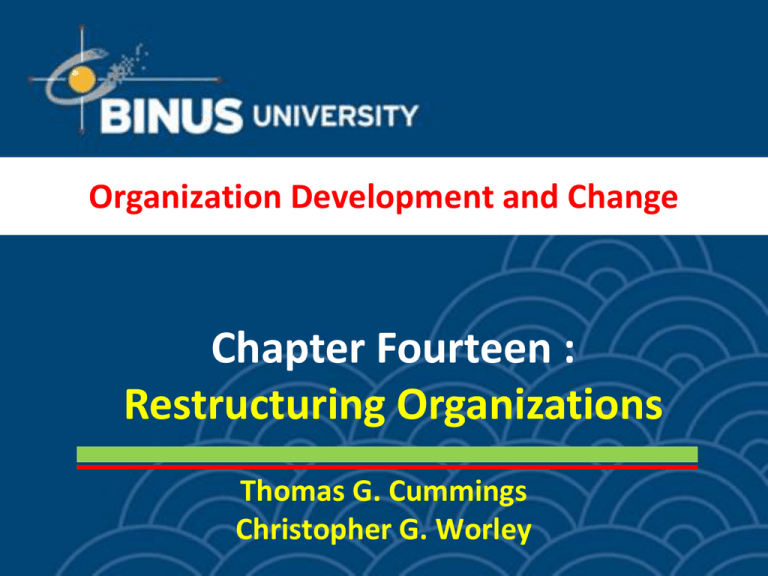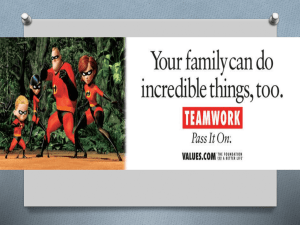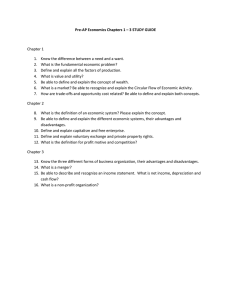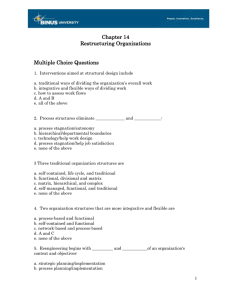Chapter Fourteen : Restructuring Organizations Organization Development and Change Thomas G. Cummings
advertisement

Organization Development and Change Chapter Fourteen : Restructuring Organizations Thomas G. Cummings Christopher G. Worley Learning Objectives for Chapter Fourteen To understand the basic principles of technostructural design To understand the three basic structural choices and two advanced structural choices available to organizations To understand the process of downsizing and reengineering 14-2 Contingencies Influencing Structural Design Environment Organization Size Technology Structural Design Worldwide Operations Organization Goals 14-3 Functional Organization President VP Research VP Operations VP Human Resources VP Marketing VP Finance 14-4 The Functional Form Advantages Disadvantages Promotes skill specialization Reduces duplication of scarce resources and uses resources full time Emphasizes routine tasks; encourages short time horizons Fosters parochial perspectives by managers and limits capacity for top-management positions Multiplies interdepartmental dependencies; increases coordination and scheduling difficulties Obscures accountability for 14-5 overall results Enhances career development for specialists within large departments Facilitates communication and performance because superiors share expertise with their subordinates Exposes specialists to others within same specialty The Divisional Organization Chief Executive Officer Chief Financial Officer Division Manager Asia VP Human Resources VP Research Division Manager North America VP Operations Division Manager Europe VP Sales and Marketing 14-6 The Divisional Form Advantages Disadvantages Recognizes interdepartmental interdependencies May use skills and resource inefficiently Fosters an orientation toward overall outcomes and clients Limits career advancement by specialists Allows diversification and expansion of skills/training Ensures accountability by departmental managers and promotes delegation Impedes specialists’ exposure to others within same specialties Puts multiple-role demands upon people and creates stress May promote departmental objectives as opposed to overall organizational goals Heightens departmental cohesion and involvement in work 14-7 The Matrix Organization President CEO VP Finance Senior VP Programs VP Human Resources Senior VP Operations VP Research VP Engineering VP Manufacturing VP Marketing Program Manager Aircraft Program Manager Navigation Systems Program Manager Space Systems 14-8 The Matrix Structure Advantages Disadvantages Makes specialized, functional knowledge available to all projects Can be difficult to implement Increases role ambiguity, stress, and anxiety Use people flexibly Maintains consistency by forcing communication between managers Performance is lowered without power balancing between projects and functions Recognizes and provides mechanisms for dealing with legitimate, multiple sources of power Makes inconsistent demands and can promote conflict and short-term crisis orientation May reward political skills over technical skills Can adapt to environmental changes 14-9 Characteristics of Process-Based Structures Processes drive structure Work adds value Teams are fundamental Customers define performance Teams are rewarded for performance Teams are tightly linked to suppliers and customers Team members are well informed and trained 14-10 The Process-Based Structure Senior Management Team Chair and Key Support Process Owners Developing New Products Process Process Owner Cross Functional Team Members Acquiring and Filling Customer Orders Process Process Owner Cross Functional Team Members Supporting Customer Usage Process Process Owner Cross Functional Team Members 14-11 The Process-Based Form Advantages Focuses resources on customer satisfaction Improves speed and efficiency Adapts to environmental change rapidly Reduces boundaries between departments Increases ability to see total work flow Enhances employee involvement Lowers costs dues to overhead Disadvantages Can threaten middle managers and staff specialists Requires changes in command-and-control mindsets Duplicates scarce resources Requires new skills and knowledge to manage lateral relationships and teams May take longer to make decisions in teams Can be ineffective if wrong processes are identified 14-12 The Customer Centric Structure 14-13 The Customer Centric Form Advantages Presents one integrated face to the customer Generates a deep understanding of customer requirements Enables organization to customize and tailor solutions for customers Builds a robust customer response capability Disadvantages Customer teams can be too inwardly focused Sharing learnings and developing functional skills is difficult Managing lateral relations between customer-facing and back office units is difficult Developing common processes front and back is problematic Clarifying the marketing function is problematic 14-14 The Network Organization Designer Organizations Producer Organizations Broker Organization Supplier Organizations Distributor Organizations 14-15 Types of Networks Internal Market Network Vertical Market Network Intermarket Network Opportunity Network 14-16 The Network-Based Form Advantages Enables highly flexible and adaptive responses Creates a “best of the best” firm to focus resources on customer and market needs Disadvantages Difficulty managing lateral relationships across autonomous organizations Each organization can leverage a distinctive competency Difficulty motivating members to relinquish autonomy to join network Permits rapid global response Sustaining membership and benefits can be problematic May give partners access to proprietary knowledge and technology Can produce “synergistic” results 14-17 The Downsizing Process Clarify the organization’s strategy Assess downsizing options and make relevant choices Implement the changes Address the needs of survivors and those who leave Follow through with growth plans 14-18 Downsizing Tactics Tactic Workforce Reduction Characteristics Reduces headcount Short-term focus Fosters transition Attrition Retirement/buyout Layoffs Changes Eliminate functions, Organization organization Redesign Medium-term focus Fosters transition & transformation Systemic Examples Changes culture Long-term focus Fosters transformation layers, products Merge units Redesign tasks Change responsibilities Foster continuous improvement Downsizing is normal 14-19 The Reengineering Process Prepare the organization Specify the organization’s strategy and objectives Fundamentally rethink the way work gets done Identify and analyze core business processes Define performance objectives Design new processes Restructure the organization around the new business processes. 14-20 Characteristics of Reengineered Organizations Work units change from functional departments to process teams Jobs change from simple tasks to multidimensional work People’s roles change from controlled to empowered The focus of performance measures and compensation shifts from activities to results. Organization structures change from hierarchical to flat Managers change from supervisors to coaches; executives change from scorekeepers to leaders 14-21 2-22




